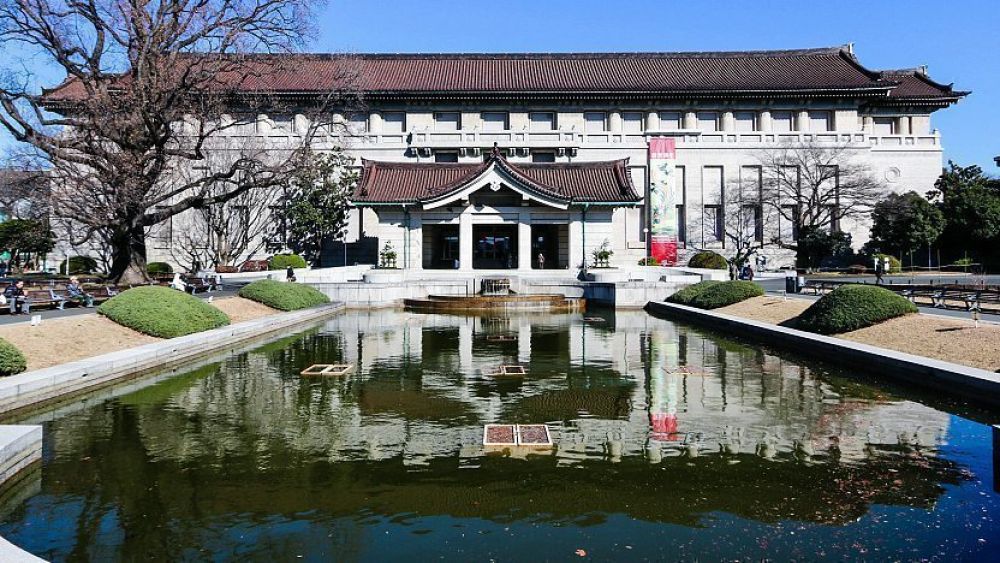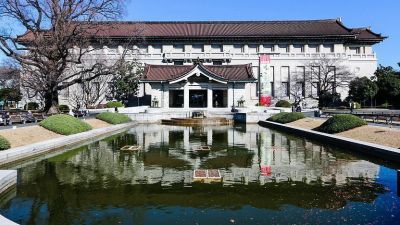

Explore the beauty of traditional Japanese art in The Japanese Gallery located in the Tokyo National Museum. Spanning several floors, the Honkan features a comprehensive collection of artworks that include ancient pottery, samurai swords, delicate textiles, and intricate lacquerware. Visitors can delve into the rich history of Japan as they observe pieces dating from the Jomon period to the Edo period. The displays are meticulously curated to showcase the evolution of Japanese aesthetics and craftsmanship, offering insight into the cultural heritage of the nation. The exhibit includes English descriptions, allowing international visitors to gain a deeper appreciation of the significance behind each artifact. The serene atmosphere of the gallery provides a contemplative environment for art enthusiasts to immerse themselves in Japan's artistic legacy.
The Asian Gallery, also known as Toyokan, is a part of the Tokyo National Museum that focuses on the arts and archeology of other Asian countries. This building houses an impressive collection that offers a window into the diverse cultures and histories of various Asian regions, including China, Korea, Southeast Asia, Central Asia, and the Middle East. As visitors wander through the gallery's rooms, they are greeted with an array of artifacts such as Chinese calligraphy scrolls, Korean ceramics, intricate Buddhist sculptures, and Persian metalwork. The gallery effectively demonstrates the connections and influences that have flowed through Asia over the centuries. The exhibition space is thoughtfully designed, ensuring that each piece is given the space to be appreciated in detail, making it an enlightening visit for those seeking to broaden their understanding of Asian arts and history.
The Gallery of Horyuji Treasures houses one of the most remarkable collections of artifacts from the Horyuji Temple, a UNESCO World Heritage Site known for its significance in the introduction of Buddhism to Japan. This modern, specially designed gallery contains a vast selection of over 300 pieces, including sacred religious relics, statues, and ancient documents that were donated by the temple to the Imperial Family in the late 19th century. The exhibits provide a rare glimpse into the early development of Buddhist art in Japan, featuring items that are over 1,000 years old. The tranquil atmosphere and the gallery's architectural design complement the spiritual and historical value of the treasures on display. Visitors interested in Buddhist art and Japanese history will find this gallery a must-see for its unique and sacred contents.
The Heiseikan serves both as a space for special thematic exhibitions and as the Japanese Archaeological Gallery. In the Archaeological Gallery, visitors can explore Japan’s ancient past through a wide array of Jomon and Yayoi pottery, burial figures known as haniwa, and other invaluable artifacts that provide insight into the daily lives and customs of people from prehistoric and ancient times. The Heiseikan's special exhibition rooms often display themed collections that rotate throughout the year, showcasing a variety of genres and periods of Japanese art and history. The spacious rooms and professional lighting enhance the viewing experience, inviting visitors to engage closely with Japan's ancestral heritage and to appreciate the detailed work of its early craftsmakers.
Dedicated to the works of Kuroda Seiki, the father of modern Western-style painting in Japan, the Kuroda Memorial Hall is a testament to the artist's influence and legacy. The hall, built in memory of Kuroda through a bequest from his family, displays an array of his masterpieces, offering visitors an insight into the introduction and adaptation of Western painting techniques in Japan. Kuroda Seiki's paintings often reflect a harmonious blend of European impressionism and realism with traditional Japanese sensibilities. Alongside the permanent collection, the hall periodically hosts special exhibitions that shine a light on the broader context of Western-influenced art movements in Japan. This is an inspiring stop for art enthusiasts who are interested in the cross-cultural exchanges that shape the art world.
While the Okyokan and Hyokeikan are less about specific collections and more about historic architecture, they do occasionally host certain exhibitions and events. The Okyokan is a traditional Japanese teahouse set within the museum's garden landscape, providing a serene and authentic experience of Japanese tea culture. Visitors can participate in tea ceremonies and enjoy the peaceful surroundings as a complement to their museum exploration. The Hyokeikan, on the other hand, is a Western-style building that reflects the architectural influence of the early 20th century. Although it mainly serves for special events and receptions, when it does host exhibitions, it provides a nostalgic backdrop that adds to the aesthetic and historical atmosphere of the displays.
Throughout the year, the Tokyo National Museum holds a number of special thematic exhibitions that draw from its vast collection, as well as from other institutions, to showcase specific eras, artistic movements, or cultural themes. These exhibitions are meticulously organized to provide depth and context to the featured topics. Visitors can expect to find unique displays ranging from ancient pottery techniques, the art of sword making, textile design, calligraphy, religious iconography, to modern artistic expressions. These exhibitions not only highlight the museum's diverse collections but also offer fresh perspectives on familiar subjects. The thematic exhibitions are perfect for repeat visitors or those looking to gain a more comprehensive understanding of a particular facet of Japanese art and culture.
Wrapped around the Tokyo National Museum is a sprawling garden that merges the beauty of nature with the elegance of traditional Japanese landscape design. Although not an indoor activity, a visit to the museum gardens can be a tranquil respite from the galleries, offering a space for reflection amidst historic trees, seasonal flowers, and quaint ponds hosting koi fish. The garden features several historic structures, including teahouses and statues, creating a picturesque exterior complement to the museum’s rich interior. Visitors can enjoy the outdoor sculptures, take a leisurely stroll along the paths, or simply sit and absorb the serene environment. The garden highlights the importance of nature in Japanese aesthetics and is a beautiful example of how art and nature intertwine.
For an interactive approach to learning about Japanese culture and history, the Tokyo National Museum offers various research and hands-on experience workshops. These programs aim to engage participants in the processes behind traditional arts and crafts, providing practical insight into ancient techniques. Workshops might include activities such as traditional painting methods, calligraphy classes, or even conservation and research techniques used by museum professionals. These activities are often led by experts in the field who provide personalized guidance to participants. Engaging in these workshops can enhance visitors’ appreciation of the artifacts on display and provide a memorable educational experience that goes beyond passive observation.
To enrich the experience of exploring the museum, audio guide rentals are available in multiple languages, including English, Japanese, Chinese, and Korean. These guides offer detailed commentary on selected works throughout the museum's permanent collections, providing historical context, artistic insights, and fascinating anecdotes that enhance visitors' understanding of the pieces on display. The audio guide allows visitors to explore the museum at their own pace and tailor their experience to their interests. Whether interested in a specific era of Japanese history, a particular type of art, or the stories behind each exhibit, the audio guide is an invaluable companion for a more thorough and intimate museum visit.
